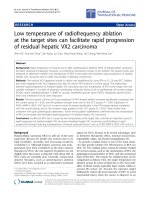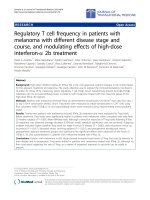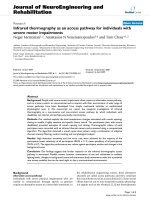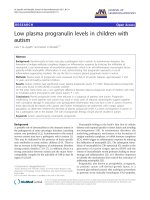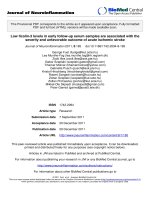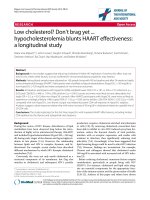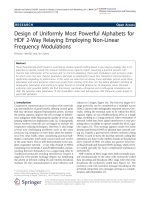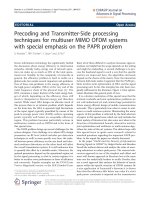báo cáo hóa học: " Low PAPR space frequency block coding for multiuser MIMO SC-FDMA systems: specific issues for users with different spectral allocations" ppt
Bạn đang xem bản rút gọn của tài liệu. Xem và tải ngay bản đầy đủ của tài liệu tại đây (528.73 KB, 10 trang )
RESEARCH Open Access
Low PAPR space frequency block coding for
multiuser MIMO SC-FDMA systems: specific
issues for users with different
spectral allocations
Cristina Ciochina
*
, David Mottier and Damien Castelain
Abstract
Single-carrier space frequency block coding (SC-SFBC) is an innovative mapping scheme suitable for implementing
transmit diversity in single-carrier frequency division multiple access (SC-FDMA) systems. The main advantage of
SC-SFBC is that it preserves the low envelope variations of SC-FDMA, which is particularly interesting for the uplink
of wireless communications systems. In this article, we apply the SC-SFBC concept in a multiuser multiple-input
multiple-output (MU-MIMO) scenario. We introduce a novel algorithm allowing the optimization of the parameters
of SC-SFBC to enable low-complexity decoding at the receiver side and to maximize the overall spectral occupancy
in MU-MI MO SC-FDMA systems, and we show the good performance of the proposed MU scheme.
Keywords: SC-FDMA, transmit diversity, single-carrier space frequency block coding, multi-user MIMO, peak to aver-
age power ratio.
1. Introduction
Orthogonal frequency division multiple access
(OFDMA) and OFDMA-based multi-carrier (MC) trans-
mission schemes have undeniab ly become one of the
main references in modern communications systems.
Almost all recent communication standards rely on an
OFDMA downlink air interface and impleme nt multi-
ple-input multipl e-output (MIMO) techniques [1]. Such
is the case in IEEE 802.11n for wireless local area net-
works, IEEE 80 2.16e-2005 for mobile WiMAX, Long-
Term Evolution (LTE) of Universal Mobile Telecommu-
nications System, and also in the future LTE-advanced
standard.
The general acceptance of OFDMA as a good option
for the downlink of recent communications systems is
motivated by its well-known advantages: good spectral
efficiency, good coverage, flexible dynamic frequency
allocation, simple equalization at tone level [2]. Even
though OFDMA is widely employed in the downlink,
its use in the uplink is hampered by the high peak-to-
average power ratio (PAPR) it displays. The PAPR pro-
blem, common for all MC transmission schemes,
induces numerous performance issues such as reduced
power efficiency, spectral regrowth and in-band distor-
tion when using nonlinear high power amplifiers (HPA).
Many efforts were directed to efficiently alleviating the
PAPR proble m [3-6], but because of either s ome
standard-compatibility issues or some practical system
limitations the problem is not yet considered as comple-
tely solved [7].
While the PAPR problem, inevitable in t he downlink,
can be coped with by using highly linear (and thus
expensive) HPAs for exampl e, this is a much more sen-
sitive issue in the uplink. Mobile users strive for good
coverage and good autonomy handsets, but do not
neglect the associated costs. On one hand, backing-off
the uplink signal level to the linear region of the HPA
would reduce the coverage. On the other hand, using
highly linear HPAs would increase the handset cost. For
these reasons, the uplink physical layer of LTE [8] was
chosen to be a precoded OFDMA air interface, called
single-carrier frequency division multiple access
(SC-FDMA). The precoder is a discrete fourier
* Correspondence:
Wireless Communications Systems, Mitsubishi Electric R&D Centre Europe,
Rennes, France
Ciochina et al. EURASIP Journal on Advances in Signal Processing 2011, 2011:54
/>© 2011 Ciochin a et al; licensee Springer. This is an Open Access article distribut ed under the terms of the Creative Commons
Attribution License ( which permits unrestricted use, distri bution, and reproduct ion in
any medium, provided the original work is properly cited.
transform (DFT), which rest ores the low envelope
fluctuations of single-carrier (SC) systems [9,10]. But
SC-FDMA may lose its low-PAPR property in MIMO
systems if no precaution is taken.
A PAPR-preservin g transmit diversity technique for
SC-FDMA, coined single-carrier space frequency block
coding (SC-SFBC), was already introduced for user with
two t ransmit antennas in [11], and some extensions to
users with four transmit antennas were also presented
in a single-user (SU)-MIMO scenario. SC-SFBC makes
use of an innovative subcarrier mapping to apply the
well-known Alamouti scheme [12] in an SC-FDMA sys-
tem at subcarrier level in the frequency domain without
degrading the PAPR.
The aim of this arti cle is to extend the SC-SFBC con-
cept to the multiuser (MU)-MIMO SC-FDMA scenario,
by notably taking into account the specific issues of
users with different spectral allocations. After the intro-
duction in Section 1, we will briefly review the princi-
ples of SC-SFBC in Section 2. Section 3 states the
problems raised by employing SC-SF BC in an MU-
MIMO transmission and explains how the parameters
of SC-SFBC can be optimized to allow MU transmission
and also gives an algorithm of spectral occupancy opti-
mization. Some results are presented in Section 4.
Finally, Section 5 presents the conclusions of this study.
2. Low-PAPR MIMO techniques for SC-FDMA
Future mobile terminals will be equipped with typically
two or even four transmit antennas and several radiofre-
quency chains. It is therefore natural to try and apply
MIMO techniques for the uplink of future wireless com-
municat ions systems, since terminals will be able to use
their multiple transmit antennas to increase throughput,
increase link quality, mitigate interference or perform a
trade-off among the above [13]. More particularly,
transmit diversity techniques are interesting to b e
applied for users at cell edge experiencing poor propaga-
tion conditions; for high mobility users not having
access to reliable channel state information (CSI); or,
more generally, for the transmission of sensitive data
such as control information, where a good reliability is
required despite the absence of feedback information.
2.1 Transmit diversity in SC-FDMA
SC-FDMA combines an SC signal with an OFDMA-like
multiple access to achieve both the low PAPR specific
to SC signals and the flexible dynamic frequency
allocation speci fic to OFDMA. In its frequency domain
implementation [8], SC-FDMA is a precoded OFDMA
transmission scheme, where precoding is done by means
of a DFT. As in all cyclic-prefixed OFDMA-based
systems, the system in the frequency domain [before
passing through the inverse DFT (IDFT)] experiences an
equivalent diagonal channel [14]. Therefore, it is af ter
the DFT precoding that a transmit diversity precoding
module must be inserted, in order to be able to cor-
rectly apply at subcarrier level space-time (ST) or space-
frequency (SF) block codes (BC) that were origi nally
designed for narrowband channels.
In Figure 1, at time t, data block vector
x
(
t)
=[x
(t)
0
x
(t)
M
−
1
]
composed of M modulation symbols
x
k
(t)
(k = 0 M-1), e.g., quadrature phase shift keying
(QPSK) symbols, is DFT-precoded by means of a
M-sized DF T F
M
. M-sized vectors S
(t)
thus obtained
undergo ST/SF precoding, resulting in M-sized vectors
s
Tx
n
,
(
t
)
, n =0 N
Tx
−
1
,whereN
Tx
is the number of
transmit antennas. These vectors are then mapped on
M out of N inputs of the IDFT
F
H
N
(the superscript (.)
H
stands for the Hermitian of a vector or matrix) accord-
ing to the subcarrier mapping strategy to be transmitted
on antennas Tx
n
. In this article, we will consider that
the mapping matrix Q corresponds to localized subcar-
rier mapping. To combat the effect of the frequency
selective channel, a cyclic prefix (CP) is inserted in front
of each N-sized block thus obtained.
Classically applying transmit diversity in SC-FDMA
systems raises several issues. Let us suppose that N
Tx
=
2.ThechoiceofanAlamouticode[12]isnaturalfora
scenario with two transmit antennas, since it has full
rate, full diversity and is easily decodable.
If trying to apply an Alamouti-based STBC (i.e., pre-
coding in the time domain between time-consecutive
frequency samples
s
(t
0
)
k
0
and
s
(t
1
=t
0
+1
)
k
0
carried by the same
k
0
th subcarrier), then we coarsen the granularity of the
system. All transmission bursts would need to be com-
posed of an even number of SC-FDMA symbols, which
is difficult to guarantee into practice.
In the LTE-Advanced system for example, for certain
formats of the uplink control channel, only five SC-
FDMA symbols will be present in a slot [15]. This
renders impossible the use of STBC. The advantage
of STBC is that it preserves the SC- like PAPR of
SC-FDMA.
On the other hand, if trying to apply an Alamouti-
based SFBC (i.e., precoding in the frequency domain
between frequency-adjacent freque ncy samples
s
(
t
0
)
k
0
and
s
(t
0
)
k
1
=k
0
+
1
belonging to the same SC-FDMA symbol), this
would increase the PAPR of the resultin g signal, as
shownin[11,16].ThemainadvantageofSC-FDMA,
which is its SC-like PAPR, would be lost. The advantage
of SFBC is its flexibility, since it can be applied to any
number of SC-FDMA symbols in a transmission burst.
Ciochina et al. EURASIP Journal on Advances in Signal Processing 2011, 2011:54
/>Page 2 of 10
2.2 The principles of SC-SFBC
SC-SFBC [11] is an innovative mapping scheme, suitable
for implementing transmit diversity in SC-FDMA sys-
tems. It conserves b oth the flexibility of SFBC and the
good PAPR of STBC. Just as classical SFBC, SC-SFBC
performs Alamouti-based precoding i n the frequency
domain between frequency samples belonging to the
same SC-FDMA symbol. The main difference with
respect to classical SFBC is that SC-SFBC precodes
between non-adjacent frequency samples
s
(
t
0
)
k
0
and
s
(t
0
)
k
1
=
(
p−1−k
0
)
mod
M
,whereM is the number of subcarriers
allocated to a user and p is an even integer satisfying 0
≤ p < M -1.Inthefollowing,thesuperscripts(t
0
)will
be omitted. SC-SFBC is constructed such as the original
SC signal is transmitted on the fist transmit a ntenna
Tx
0
and a transformed signal is transmit ted on the
second transmit antenna Tx
1
:
s
Tx
0
= s
s
Tx
1
=SC
p
M
(
s
)
(1)
The
S
C
p
M
(
s
)
operation consists in tak ing the complex
conjugates of vector s in reversed order, applying alter-
native sign changes and then cyclically shifting down i ts
elements by p positions. This is depicted in Figure 2.
Alamouti-precoded pairs appear on couples of non-adja-
cent subcarriers (k
0
, k
1
) with:
k
1
=
p − 1 − k
0
mod M
.
(2)
Intuitively, based on the properties of the Fourier
transform, the frequency domain
SC
p
M
operation (con-
sisting in spectrum reversal, alternative sign changes and
frequency domain shifting by p positions) does not
impact on the SC nature of the signal, since neither
spectrum shuffling nor amplitude modi fications of the
spectral components are performed. Indeed, in the time
domain, the
S
C
p
M
operation is equivalent to complex
conjugation and phase shif ts, but no amplitu de modifi-
cation is performed. It is fully p roven in [11], both
analytically and by means of simulation, that SC-SFBC
does not increase the PAPR of the resulting signal and
that th e signal
y
Tx
1
on the second transmit antenna Tx
1
has the same PAPR as the original SC-FDMA signal
y
Tx
0
, both for localized and for distributed subcarrier
mapping. In the case of localized subcarrier mapping for
example, in [11] it is proven that
y
Tx
1
n
=
y
Tx
0
n+N/2
, n = 0 N −
1
(3)
Equation 3 formally proves that
y
Tx
1
has strictly the
same PAPR as the original SC-FDMA signal
y
Tx
0
,and
the simulation results are reproduced in Figure 3.
The maximum separation between subcarriers
car rying frequency samples precoded together is max(p,
M - p) and is thus controlled by the parameter
p. Distan t subcarriers might experience different or even
uncorrelated channel realizations, which generates some
interference within the Alamouti-precoded pair. Some
slight performance degradation can therefore occur on
very selective channels and/or when the precoding
distance is rather large. The optimum value of p, mini-
mizing the maximum distance between subcarriers car-
rying Alamouti pairs, is the even integer closest to M/2:
p
opt
=2· floor
M/4
(4)
Figure 1 SC-FDMA transmitter with ST/SF precoding (M out of
N allocated subcarriers, N
Tx
transmit antennas).
0
Tx
:s
1
Tx
:s
6
12
SC
p
M
6
p
n
*
0
s
*
3
s
*
1
s
*
2
s
*
4
s
*
5
s
*
6
s
*
7
s
*
8
s
*
9
s
*
10
s
*
11
s
3
s
1
s
2
s
4
s
5
s
6
s
7
s
0
s
8
s
9
s
10
s
11
s
Figure 2 SC-SFBC precoding; example for M = 12, p =6.
-2 0 2 4 6 8 1
0
10
-6
10
-5
10
-4
10
-3
10
-2
10
-1
10
0
J
2
(dB)
Prob(INP>
J
2
)
SC-FDMA;
SC-SFBC, Tx
0
and Tx
1
;
SFBC Tx
0
SFBC Tx
1
OFDMA
Figure 3 The distribution of the instantaneous normalized
power (INP): SC-FDMA, SC-SFBC, classical SFBC, OFDMA.
Ciochina et al. EURASIP Journal on Advances in Signal Processing 2011, 2011:54
/>Page 3 of 10
SC-SFBC can benefit from low-complexity frequency-
domain dec oding. Indeed, couples of subcarriers (k
0
,k
1
)
carrying Alamouti pairs can be identified and separately
decoded. To minimize the impact of the interference
created within the Alamouti pair by precoding onto dis-
tant subcarriers, minimum mean square error (MMSE)
is employed instead of the maximum ratio combining
usually employed in Alamou ti decoding. MMSE decod-
ing remains low-complexity (inversion of one order-2
matrix for each of the M/2 Alamouti pairs in one SC-
FDMA symbol).
3. Multi-user SC-SFBC
So far, the study reviewed in the previous section
concentrated on transmit diversity techniques for
SU-MIMO transmission, where each mobile sta tion
(MS) uses its transmit antennas to improve the perfor-
mance at a given throughput, making use of the avail-
able spat ial diversity. Let us now introduce the
principles of SC-SFBC in a MU-MIMO scenario.
3.1 Extending SC-SFBC to MU transmission
We consider that several users, each user having an MS
equipped with two transmit antennas, are managed by
the same base station (BS). The BS tries to optimally
map the uplink signals of these users in a given limited
bandwidth. Each such user implements SC-SFBC as a
transmit diversity scheme. According to the desired
throughput, to the capabilities of each MS and to the
corresponding c hannel quality, the scheduler at the BS
will decide the modulation and coding scheme (MCS)
and the spectral allocation of each user. To optimize the
spectral occupancy and increase the throughput, it is
interesting to allow some spectral reuse between users
having ei ther the same or different overlapping allocated
bandwidths.
Let us assume that the scheduler allows two users
(MS
0
and MS
1
) to share some (or all) of the subcarriers
allocated to each user. Each user is employing transmit
diversity techniques, e.g., SC-SFBC, and there is some
spectral overlapping between users. More clearly, the
MU-MIMO scheme used here combines spatial multi-
plexing with SC-SFBC. This is depicted in Figure 4. The
MU-MIMO channel has N
TX
= N
TX
+ N
TX
= 4 transmit
antennas (two antennas for each of the two user). At
least two receive antennas are needed at the BS to sepa-
rate the two users.
At the scheduler, the n umber of subcarriers M
i
,as
well as the starting position n
i
of the portion of spec-
trum allocated to each MS
i
, is computed. When SC-
SFBC is used, Equation 4 shows that, to minimize the
maximum distance between subcarriers coded together,
the best strateg y is to employ
S
C
p=2floor(M/4
)
M
. For
sim plification, let us cons ider in the following that M is
a multiple of 4 and thus p
opt
= M/2.InanMU-MIMO
context, double SC-SFBC might have some pairing
incompatibility problems. Indeed, let us analyze the
situation depicted in Figure 5, where MS
0
is allocated
M
0
= 8 subcarriers and MS
1
is allocated M
1
=12sub-
carriers. The portions of spectrum occupied by the two
MSs start with the same spectral p osition n
0
= n
1
=0,
which means that the first occupied subcarrier by each
MS is the one with index 0, denoted as f
0
in Figure 5.
Therefore, MS
0
should use
S
C
4
8
and MS
1
should use
S
C
6
12
. Subcar riers with indexes (k
0
, k
1
) obtained by
applying Equation 2 contain Alamouti pairs. Each MS
uses its optimum p parameter, respectively, p
0
= 4 and p
1
= 6 in this example. On the fifth occupied subcarrier f
4
for
example, MS
0
transmits frequency samples s
4
and
−s
∗
7
onto its two transmit antennas, respectively. Next, f
4
is
paired with f
7
, onto which MS
0
transmits frequency sam-
ples s
7
and
s
∗
4
, respectively. On the same subcarrier f
4
,MS
1
transmits frequency samples
s
4
and
−s
∗
1
, respectively, onto
Figure 4 MU-MIMO SC-SFBC: two users with spectral
overlapping.
0
T
x
s
1
T
x
s
2
T
x
s
3
T
x
s
3
:
f
1
:
f
2
:
f
4
:
f
5
:
f
6
:
f
7
:
f
0
:
f
8
:
f
9
:
f
10
:
f
11
:
f
*
0
s
*
3
s
*
1
s
*
2
s
*
4
s
*
6
s
*
7
s
*
5
s
3
s
1
s
2
s
4
s
5
s
6
s
7
s
0
s
*
0
s
c
*
3
s
c
*
1
s
c
*
2
s
c
*
4
s
c
*
6
s
c
*
7
s
c
*
5
s
c
*
10
s
c
*
8
s
c
*
9
s
c
*
11
s
c
3
s
c
1
s
c
2
s
c
4
s
c
5
s
c
6
s
c
7
s
c
0
s
c
8
s
c
9
s
c
10
s
c
11
s
c
0
0
/2
SC
M
M
1
1
/
2
SC
M
M
Figure 5 MU doub le SC-SFBC with incompatible pairing of
subcarriers; example for M
0
=8,p
0
=4,M
1
= 12, p
1
=6.
Ciochina et al. EURASIP Journal on Advances in Signal Processing 2011, 2011:54
/>Page 4 of 10
its two transmit antennas. Since MS
1
uses
S
C
6
12
, f
4
is
paired with f
1
. As a result, the pairing of subcarriers is not
compatible between MS
0
and MS
1
. Because of this incom-
patibility, this structure does not correspond to a double
SC-SFBC construction and the conventional MMSE sim-
plified detector cannot be employed anymore.
A joint MMSE detection over all the bandwidth con-
taining cross-codes subcarriers is necessary in this case.
For the example in Figure 5, this would involve invert-
ing a matrix of order M
0
+ M
1
= 20 instead of two
matrices of order 4 and two matrices of order 2, as it
would have been the case if the two MS were correctly
aligned to form double Alamouti pairs on the overlap-
ping subcarri ers, and simple Alamouti pairs on the
remaining subcarriers. The problem becomes even more
complex when three or more users h ave overlapping
subcarriers. This complexityissueisarealproblemin
practice. Since the number of subcarriers allo cated to
each user is variable, and the number of users having
partially overlapping transmission bandwidths with one
another may be more than 2, the receiver must be
dimensioned for the worst-case scenario and should be
able to invert matrices of rank hundreds or thousands.
For an LTE transmission in the 5-MHz bandwidth
(using 300 data carriers for example), the receiver
should be dimensioned so as to be able t o invert
matrices of order 600.
3.2 Parameter optimization
To show how this incompat ibility problem can be
avoided, let us notice that any
S
C
p
M
operation can be
seen as the concatenation of
SC
0
p
and
SC
0
M−
p
operati ons,
applied onto the first p and, respectively, the last M-p
samples of the input vector:
SC
p
M
s
0
s
M−1
=
SC
0
p
s
0
s
p−1
, SC
0
M−p
s
p
s
M−1
(5)
This is a direct result of the very structure of SC-
SFBC. Indeed, in the example in Figure 2, we not ice
that
s
Tx
1
=SC
6
12
s
Tx
0
while the first (respectively last)
six frequency samples of
s
Tx
1
respect the relationship:
⎧
⎪
⎨
⎪
⎩
s
Tx
1
0
s
Tx
1
p−1=5
=SC
0
p=6
s
Tx
0
0
s
Tx
0
p−1=5
s
Tx
1
p=6
s
Tx
1
M−1=11
=SC
0
M−p=6
s
Tx
0
p=6
s
Tx
0
M−1=11
(6)
Let us denote the numb er of subcarriers simulta-
neously used by two MSs by M
overlap
. To avoid any pair-
ing incompatibility, the two MSs need to transmit the
same symbol structure over the overlapping spectral
portion. Based on the property stated above, whe n the
two M Ss have strictly different spectral allocations, the
only valid opt ion is to chose p parameters p
i
and
spectrum positions n
i
such that the overlapping portion
has a structure based on
SC
0
M
overla
p
.Whileanoptimiza-
tion of parameter p has no direct impact on the allo-
cated set of subcarriers, an optimization of the spectrum
positions n
i
limits the flexibility of the frequency
scheduler.
ThecasewherethetwoMSshavethesamenumber
of allocated subcarriers M
0
= M
1
and share the same
bandwidth is trivial since no pairing incompatibility
arises. Pairs of subcarriers (k
0
,k
1
) carrying d ouble Ala-
mouti pairs can be identified and low-complexity
MMSE decoding can be applied (involving M/2 order-4
matrix inversions). We only treat here of the case of
different spectral allocation M
0
≠ M
1
, let us assume for
example M
0
<M
1
. The case of users with the same
number of allocated subcarriers M
0
= M
1
but different
allocated bands n
0
≠ n
1
can be treated in a similar
manner.
For n
0
= n
1
, a solution is given in Figure 6. We need
to impose MS
0
to use
S
C
p
0
=
0
M
0
and MS
1
to use
S
C
p
1
=M
0
M
1
.
The
S
C
p
1
=M
0
M
1
can be seen as the concatenation of two
SC-like operations
•
S
C
0
M
0
to match the configuration of MS
0
;onthis
part of the spectrum , double SC-SFBC transmission
can thus be employed;
• The remaining
S
C
0
M
1
−M
0
corresponds to a simple
SC-SFBC transmission and keeps an overall SC-type
signal to be transmitted by MS
1
.
Hence, it is no longer possible to use a default value
for the p parameter for all the system (highest even inte-
ger inferior to half of the respective number of allocated
0
Tx
s
1
Tx
s
2
Tx
s
3
Tx
s
3
:f
1
:f
2
:f
4
:f
5
:f
6
:f
7
:f
0
:f
8
:f
9
:f
10
:f
11
:f
*
0
s
*
3
s
*
1
s
*
2
s
*
4
s
*
6
s
*
7
s
*
5
s
3
s
1
s
2
s
4
s
5
s
6
s
7
s
0
s
*
0
s
c
*
3
s
c
*
1
s
c
*
2
s
c
*
4
s
c
*
6
s
c
*
7
s
c
*
5
s
c
*
10
s
c
*
8
s
c
*
9
s
c
*
11
s
c
3
s
c
1
s
c
2
s
c
4
s
c
5
s
c
6
s
c
7
s
c
0
s
c
8
s
c
9
s
c
10
s
c
11
s
c
0
0
SC
M
0
0
SC
M
10
0
SC
MM
0
1
SC
M
M
Figure 6 MU double SC-SFBC M
0
<M
1
,anexampleforM
0
=8,
M
1
= 12, p
0
=0,p
1
=8,n
0
= n
1
.
Ciochina et al. EURASIP Journal on Advances in Signal Processing 2011, 2011:54
/>Page 5 of 10
subcarriers), but double SC-SF BC structure is kept at
the expense of a modification of the p parameter, i.e.,
some performance degradation as the maximum dis-
tance between subcarriers that are jointly precoded is
increased. But, complexity is strongly reduced: only two
matrices of order 4 and two matrices of order 2 need to
be inverted during MMSE decoding for the example in
Figure 6, while for the structure in Figure 5 an inversion
of an order-20 m atrix was required. It shou ld also be
noted that additional signaling is necessary to indicate
the values of p to be used by each MS in this case.
Analternativesolutionforthecasewhenthespectral
bands allocated to the two MSs do not have the same
spectral starting position is to decompose
S
C
p
1
M
1
into
S
C
0
p
1
and
S
C
0
M
1
−
p
1
, and to allocate MS
0
in the middle of
the bandwidth occupied by
S
C
0
p
1
if p
1
>M
0
,orinthe
middle of the b andwidth occupied by
S
C
0
M
1
−
p
1
other-
wise. An example is depicted in Figure 7. Nevertheless,
this might lead to a modified double SC-SFBC (there is
a sign inversion within the double SC-FDMA pair on
antenna Tx
3
) which needs to be taken into account at
the receiver, with out any performance loss. In both
cases depicted in Figures 6 and 7, it is possible to allow
double SC-SFBC; thanks to an optimization of para-
meter p only.Noconstraintisintroducedinthefre-
quency scheduler to optimize n
0
and n
1
.
3.3 Optimization of spectral occupancy
Let us now extend the particular cases treated in the
previous section to a general framework where a BS
manages several MS, let their number be N
users
.We
propose here to optimize not only the parameter p but
also the spectrum positions n
i
so as to allow using dou-
ble SC-SFBC by several terminals having overlapping
spectrum allocations.
Depending on the needs and capabilities of uplink
communication of each MS, the BS determines the
number of subcarriers M
i
all ocated to each MS
i
, i = 0
N
users
- 1. Each MS is equipped of at least two transmit
antennas. Each MS uses SC-FDMA with SC-SFBC trans-
mit diversity for its uplink communication. Our purpose
is to schedule these N
users
MSs in such a manner that
the occupied bandwidth is minimized and the overall
throughput is optimized. The couple (p
i
, n
i
), re present -
ing the p parameter and the first occupied subcarrier,
needs to be determined for each MS
i
.
The main idea behind the solution is to determine two
groups of users, A and B. Spectral bands allocated to
each user do not overlap inside of each group, but each
user of each group can have overlapping subcarriers
with a maximum of two users from the other group,
such as onto the overlapping subcarriers double Ala-
mouti pairs are formed.
Let subcarrier numbering starting at
n
A
0
=0
;
n
B
0
can
be either null or take another positive value. n
A
and n
B
are auxiliary parameters indicating the index of the
first available subcarrier in groups A and B, re spec-
tively. We sup pose that BS tries to map N
users
MSs in
a bandwidth that is as compact as possible (alterna-
tively, it could have one given available bandwidth and
would try to map as many users as possible; algorithm
still stands b ut the STOP condition needs to be modi-
fied). The algorithm presented in the Annex (addi-
tional file 1) tries to minimize the number of
subcarriers allocated to only one single MS to improve
the overall spectral efficiency, while forming double
SC-SFBC pairs on the subcarriers simultaneously allo-
cated to two MSs to ensure low-complexity decoding.
The principle of this algorithm is to use the fact that
the SC operator can be decomposed as shown in Sec-
tion 3.2, with the purpose of optimizing the spectral
occupancy. Users are treated one at a time, and at
each step the treated user is allocated a p parameter
such as to share a maximum number of subcarriers
withtheprevioususerbyforming“double Alamouti”
pairs. STOP condition is attained when all the users
have been scheduled.
Let us apply the al gorithm in Annex (additional file 1)
for a BS that schedules four MSs with different commu-
nication needs, and decides to allocate them, respec-
tively, M
0
= 12, M
1
=8,M
2
=8,M
3
= 4 subcarriers
START:
i =0, n
A
0
=0, n
B
0
=0, N
users
=
4
n
A
= n
A
0
=0, n
B
= n
A
0
+ n
B
0
=
0
0
Tx
s
1
Tx
s
2
Tx
s
3
Tx
s
3
:f
1
:f
2
:f
4
:f
5
:f
6
:f
7
:f
0
:f
8
:f
9
:f
10
:f
11
:f
*
0
s
*
3
s
*
1
s
*
2
s
*
4
s
*
5
s
3
s
1
s
2
s
4
s
5
s
0
s
*
0
s
c
*
3
s
c
*
1
s
c
*
2
s
c
*
4
s
c
*
6
s
c
*
7
s
c
*
5
s
c
*
10
s
c
*
8
s
c
*
9
s
c
*
11
s
c
3
s
c
1
s
c
2
s
c
4
s
c
5
s
c
6
s
c
7
s
c
0
s
c
8
s
c
9
s
c
10
s
c
11
s
c
0
0
SC
M
0
1
SC
pM
M
!
Figure 7 Double SC-SFBC, M
0
<M
1
, an example for M
0
=6,M
1
= 12, p
0
=0,p
1
=8,n
0
>n
1
.
Ciochina et al. EURASIP Journal on Advances in Signal Processing 2011, 2011:54
/>Page 6 of 10
i <N
users
? YES:
Select MS
0
, determine M
0
=12
n
A
<n
B
? NO:
n
A
= n
B
? YES:
Select MS
1
, determine M
1
=8
M
0
= M
1
? NO:
n
0
= n
1
=0,p
0
= M
1
=8,p
1
=0
n
A
= 12, n
B
=8,i =2
i <N
users
? YES:
Select MS
2
, determine M
2
=8
n
A
<n
B
? NO:
n
A
= n
B
? NO:
M
2
>n
A
-n
B
? YES
n
2
= n
B
=8,p
2
= n
A
-n
B
=4
n
B
= 16, i =3
i <N
users
? YES:
Select MS
3
, determine M
3
=4
n
A
<n
B
? YES:
n
A
= n
A
0
? NO:
M
3
>n
B
-n
A
? NO:
n
4
= 12, p
4
=0
i =4
i <N
users
? NO:
STOP.
The results are depicted in Figure 8. In a similar man-
ner, all the cases depicted in Figures 6 and 7 can be
deduced based on this algorithm.
Of course, this scheduling strategy directly constrains
the frequency scheduler. However, it should be under-
stood that transmit diversity is mainly intended for
terminals that cannot benefit from any clo se-loop pro-
cessing as CSI-based frequenc y scheduling. In other
words, no frequency scheduling gain ca n be achieved
in this case and the constraint imposed on the f re-
quency scheduler is only a specific ordering o f each
allocated spectrum, given predetermined spectrum
sizes M
i
.
4. Simulation results
Let us consider an SC-FDMA system with N = 512 sub-
carriers, among which 300 are active data carriers, to fit
a bandwidth of 5 MHz. To retrieve frequency diversity,
groups of 12 SC-FDMA symbols with QPSK signal map-
ping are encoded together with a rate-1/2 turbo code
using the LTE interleaving pattern [8]. A CP with a
length of 36 samples is employed. We consider an
uncorrelated Vehicular A MIMO channel with six taps
and a maximum delay spread of 2.51 μs [17]. Localized
subcarrier mapping and ideal channel estimation are
assumed. We employ MMSE detection, with successive
interference cancelling to reduce the inter-user interfer-
ence in the MU-MIMO case.
From the discussion in Section 2.2, we can deduce
that not using the individual optimum p parameter (4)
for the schemes proposed in Se ction 3 might lead to
some performance degradation. Let us first evaluate the
severity of this degradation in the SU case. Let us con-
sider that M = 120 localized subcarriers (covering
around five times the channel coherence bandwidth) are
allocated to a user traveling at 3 kmph, and benefiting
from perfect channel estimation and MMSE decoding.
Figure 9 analyzes how t he choice o f parameter p influ-
ences the performance of SC-SFBC. Performance is eval-
uated in terms of frame error rate (FER). p = 60 and p =
30, corresponding to p = M/2 and p = M/4, respectively,
have similar performance. Employing p =16andp =0
leads to a degradation of 0.2 and 0.4 dB, respectively.
For vehic ular A channel and for the present simulation
paramet ers, the correlation bandwidth B
coh
corresponds
to approximately 26 subcarriers. In these conditions,
when employing p =60andp = 30, about 43% of the
Alamou ti pairs (26 out of 60 pairs) are situated on sub-
carriers having highly correlated fadings. This percen-
tage drops to 35 and 21% when choosing p =16andp
= 0, respectively. This is a worst-case scenario, since
users needing to employ transmit diversity are usually in
bad propagation conditions and are allocated rather
small numbers of subcarriers. We can thus conclude
that the associated performance degradation due to
optimizing the p parameter as proposed in Sections 3.2
and 3.3 is negligible in practice.
Let us now investigate the performance of the MU
double SC-SFBC scheme with low decoding complexity
proposed in Section 2.2 with respect to the MU SC-
SFBC scheme with incompatible subcarrier pairing (e.g.,
like in Figure 5). We consider that M
0
= 60 and, respec-
tively, M
1
= 20 localized subcarriers are allocated to two
users and four receive antennas are present at the BS.
For the MU double S C-SFBC scheme, the p parameters
Ciochina et al. EURASIP Journal on Advances in Signal Processing 2011, 2011:54
/>Page 7 of 10
Figure 8 MU double SC-SFBC, an example for M
0
=12,M
1
=8,M
2
=8,M
3
=4,p
0
=8,p
1
=0,p
2
=4,p
3
=0,n
0
= n
1
=0,n
2
=8,n
3
=12.
Ciochina et al. EURASIP Journal on Advances in Signal Processing 2011, 2011:54
/>Page 8 of 10
are not optimal from a user-egoistic point of view, since
they were optimized with the aim of reducing the
decoding complexity. As shown in Figure 9 and 9dis-
cussed in the previous paragraph, this might lead to
some performance degradation.
The results of this evaluation are presented in Figure
10. In both cases, MS
0
performs better than MS
1
because of the higher frequency diversity (more allo-
cated subc arriers), and of lower inter-user interference
profile (MS
0
only suffers from inter-user interference
within 1/5 of i ts spectrum, while MS
1
is interfered
within the totality of its spectrum). At a target FER of 2
×10
-2
,forMS
0
, both schemes exhibit similar perfor-
mance. For MS
1
, the MU SC-SFBC with incompatible
subcarrier pairing has a slight advantage (0.14 dB), due
to the use of user-egoistic optimum p parameters, as
explained in Figure 9. Nevertheless, the performance dif-
ference between MU SC-SFBC with incompatible pair-
ing and MU double SC-SFBC with low decoding
complexity is negligible. This is in favor of the latter
scheme, who exhibits a much lower complexity
decoding.
5. Conclusions and future work
SC-FDMA imposed itself as a good option for the
uplink air interface of wireless communications systems.
In order to preserve its main advantage, which consists
in the low envelope variations it exhibits, special care
needs to be taken when applying MIMO techniques in
SC-FDMA systems. SC-SFBC has already been proposed
as a robust SU-MIMO transmit diversity scheme com-
patible with SC-FDMA. In t his article, we extended the
principles of SC-SFBC to MU-MIMO.
A novel algorithm allowing the optimization of the
parameters of SC-SFBC to enable low-complexity
decoding at the receiver side and to maximize the over-
all spectral occupancy in MU-MIMO SC-FDMA sys-
tems is introduced. We show the good performance of
the proposed algorithm. Future study will concentrate in
further inves tigation of the proposed algorithm, includ-
ing throughput evaluations for several MCSs.
Additional material
Additional file 1: Annex A. PDF file containing Annex A.
Acknowledgements
Part of the study presented in this article was developed within the
framework of the European collaborative research project “Advanced Radio
Interface TechnologIes for 4G SysTems” (ARTIST 4G). The authors would also
like to thank Mr. Xiaoran Jiang for his helpful input concerning the
evaluation of the techniques presented in this article.
Competing interests
The authors declare that they have no competing interests.
Received: 15 October 2010 Accepted: 8 September 2011
Published: 8 September 2011
References
1. WWR Forum (ed.), in Technologies for the Wireless Future, vol. 3. (John Wiley,
2008)
2. H Sari, G Karam, I Jeanclaude, Frequency-domain equalization of mobile
radio and terrestrial broadcast channels, in GLOBECOM’94 (December 1994)
3. J Tellado, Multicarrier Modulation with Low Peak to Average Power
Applications to xDSL and Broadband Wireless (Kluwer Academic Publishers,
Boston, 2000)
4. Z Li, X-G Xia, PAPR reduction for repetition space-time-frequency coded
MIMO-OFDM systems using Chu sequences. IEEE Trans Wireless Commun.
7(4), 1195–1202 (2008)
5. T Jiang, Y Wu, An overview: peak-to-average power ratio reduction
techniques for OFDM signals. IEEE Trans Broadcast. 54(2), 257–268 (2008)
-1 0 1 2 3 4
5
10
-3
10
-2
10
-1
10
0
E
b
/N
0
(dB)
FER
p=60
p=30
p=16
p=0
Figure 9 2 × 2 SC-SFBC with variable p: 3 kmph, 120 localized
subcarriers, QPSK 1/2, MMSE decoding with ideal channel
estimation.
Figure 10 Performance comparison of SC-SFBC with
incompatible subcarrier pairing and MU double SC-SFBC with
reduced decoding complexity, an example for M
0
= 60, M
1
=
20, QPSK 1/2, N
Rx
=4.
Ciochina et al. EURASIP Journal on Advances in Signal Processing 2011, 2011:54
/>Page 9 of 10
6. H Ochai, H Imai, Performance of the deliberate clipping with adaptive
symbol selection for strictly band-limited OFDM systems. IEEE J Sel Areas
Commun. 18(11), 2270–2277 (2000). doi:10.1109/49.895032
7. C Ciochina, F Buda, H Sari, An analysis of OFDM peak power reduction
techniques for WiMAX systems, in ICC’06, (Istanbul, Turkey, June 2006)
8. 3rd Generation Partnership Project; Technical Specification Group Radio
Access Network; Evolved Universal Terrestrial Radio Access (E-UTRA),
“Physical Channels and Modulation (Release 9)”. 3GPP TS 36.211 V9.1.0
(March 2010)
9. HG Myung, J Lim, DJ Goodman, Single carrier FDMA for uplink wireless
transmission. IEEE Veh Technol Mag. 3(1), 30–38 (2006)
10. HG Myung, J Lim, DJ Goodman, Peak-to-average power ratio of single
carrier FDMA signals with pulse shaping, in 17th Annual IEEE International
Symposium on Personal, Indoor and Mobile Radio Communications
(PIMRC’06), (Helsinki, Finland, September 2006)
11. C Ciochina, D Castelain, D Mottier, H Sari, New PAPR-preserving mapping
methods for single-carrier FDMA with space-frequency block codes. IEEE
Trans Wirel Commun. 8(10), 5176–5186 (2009)
12. SM Alamouti, A simple transmit diversity technique for wireless
communications. IEEE J Sel Areas Commun. 16(8), 1451–1458 (1998).
doi:10.1109/49.730453
13. D Tse, P Viswanath, Fundamentals of Wireless Communication (Cambridge
University Press, Cambridge, 2005)
14. Z Wang, G Giannakis, Wireless multicarrier communications. Signal Process
Mag IEEE. 17(3), 29–48 (2000). doi:10.1109/79.841722
15. 3rd Generation Partnership Project; Technical Specification Group Radio
Access Network; Evolved Universal Terrestrial Radio Access (E-UTRA),
“Multiplexing and Channel Coding (Release 10)”. 3GPP TS 36.212 V10.1.10
(March 2011)
16. 3rd Generation Partnership Project, RAN1, Performance Evaluations of
STBC/SFBC Schemes in E-UTRA Uplink, R1-063179, Alcatel
17. 3GPP TR 25.996 V7.0.0 (2007-06), Spatial channel model for Multiple Input
Multiple Output (MIMO) simulations
doi:10.1186/1687-6180-2011-54
Cite this article as: Ciochina et al.: Low PAPR space frequency block
coding for multiuser MIMO SC-FDMA systems: specific issues for users
with different spectral allocations. EURASIP Journal on Advances in Signal
Processing 2011 2011:54.
Submit your manuscript to a
journal and benefi t from:
7 Convenient online submission
7 Rigorous peer review
7 Immediate publication on acceptance
7 Open access: articles freely available online
7 High visibility within the fi eld
7 Retaining the copyright to your article
Submit your next manuscript at 7 springeropen.com
Ciochina et al. EURASIP Journal on Advances in Signal Processing 2011, 2011:54
/>Page 10 of 10
